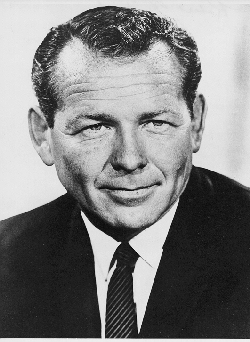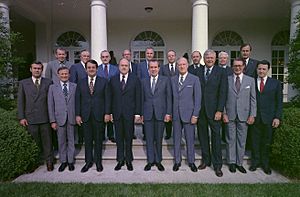Robert Finch (American politician) facts for kids
Quick facts for kids
Robert Finch
|
|
|---|---|
 |
|
| Counselor to the President | |
| In office June 23, 1970 – December 15, 1972 |
|
| President | Richard Nixon |
| Preceded by | Bryce Harlow Pat Moynihan |
| Succeeded by | Anne Armstrong |
| 8th United States Secretary of Health, Education, and Welfare | |
| In office January 21, 1969 – June 23, 1970 |
|
| President | Richard Nixon |
| Preceded by | Wilbur J. Cohen |
| Succeeded by | Elliot Richardson |
| 38th Lieutenant Governor of California | |
| In office January 2, 1967 – January 21, 1969 |
|
| Governor | Ronald Reagan |
| Preceded by | Glenn M. Anderson |
| Succeeded by | Edwin Reinecke |
| Personal details | |
| Born |
Robert Hutchinson Finch
October 9, 1925 Tempe, Arizona, U.S. |
| Died | October 10, 1995 (aged 70) Pasadena, California, U.S. |
| Resting place | Forest Lawn Memorial Park |
| Political party | Republican |
| Spouse | Carol Crothers (m. 1946) |
| Children | 4 |
| Education | Occidental College (BA) University of Southern California (LLB) |
| Military service | |
| Allegiance | |
| Branch/service | |
| Years of service | 1951–1953 |
| Battles/wars | Korean War |
Robert Hutchinson Finch (born October 9, 1925, died October 10, 1995) was an American politician. He was a member of the Republican Party. From 1967 to 1969, he served as the Lieutenant Governor of California. Later, he became the Secretary of Health, Education, and Welfare in 1969. He also worked as a top advisor to President Richard Nixon from 1970 to 1972.
Early Life and Education
Robert Finch was born in Tempe, Arizona. His father, Robert L. Finch, was a member of the Arizona House of Representatives. Robert Finch joined the Marine Corps during World War II. On February 14, 1946, he married Carol Crothers. They had four children: Maureen, Kevin, Priscilla, and Cathleen.
After his military service, Finch attended Occidental College in Los Angeles. He earned his bachelor's degree in 1947. After college, he moved to Washington, D.C. There, he worked for Congressman Norris Poulson from California. During this time, he met and became friends with Richard Nixon. Nixon later became president.
Following Nixon's advice, Finch returned to California. He studied law at the University of Southern California. He received his law degree (LL.B.) in 1951.
Political Career and Public Service
Robert Finch was involved in politics from a young age. He worked on Norris Poulson's election campaign in 1946. He also helped with Richard Nixon's campaign in 1948. After getting his law degree, he served as a Marine officer. This was during the Korean War from 1951 to 1953.
Finch tried to become a member of the U.S. Congress. He ran in 1952 and 1954 but did not win. From 1956 to 1958, he led the Republican Party in Los Angeles County. In 1958, he went back to Washington, D.C. He worked as an aide for Vice-President Nixon.
In 1960, Finch was the campaign manager for Nixon's presidential election. Nixon ran against John F. Kennedy. In 1964, Finch helped George Murphy win his campaign for U.S. Senator.
In 1966, Robert Finch was elected the Lieutenant Governor of California. He actually received more votes than Ronald Reagan, who became Governor at the same time. In 1968, Finch was a main advisor for Nixon's presidential campaign. After Nixon won, Finch was appointed Secretary of Health, Education, and Welfare. This role involved overseeing health and education programs.
In 1970, Finch left that position. He became a special advisor, or Counselor to the President, for President Nixon. He left the White House in December 1972. He then practiced law in Pasadena, California. He continued to be involved in Republican politics.
Finch ran for the U.S. Senate in California in 1976. However, he lost in the primary election to S. I. Hayakawa.
During the 1968 presidential election, Richard Nixon first wanted Finch to be his running mate for Vice President. But Finch said no. So, Nixon chose Spiro Agnew instead. Finch and Nixon remained close friends. They stayed in touch until Nixon passed away in 1994.
Later Life and Passing
Robert Finch passed away from heart disease in Pasadena, California. This happened on October 10, 1995, one day after his 70th birthday. He is buried at Forest Lawn Memorial Park, Glendale.


